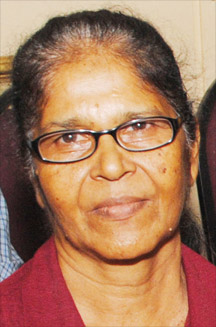On Tuesday Sahodori Megnauth took the day off to travel to Georgetown to receive an award from Partners of the Americas for her work as one of a growing number of converts to hydroponic vegetable production.
She appeared pleased to be in company of fellow farmers and more particularly fellow participants in a project that could open new and worthwhile vistas for Guyana’s agricultural sector.

On Tuesday she was one of 48 farmers recognized at a ceremony titled the Assembly of Hydroponic Vegetable Producers convened at the Pegasus Hotel.
Megnauth comes from a Mahaica Creek farming family which, over the years, had planted everything from cash crops to rice. She moved to Bath Settlement on the West Coast Berbice in the late 1970s, where she now resides with her own family. Up until a few years ago, she contributed a healthy subsidy to her husband’s wages as an employee of GuySuCo, cultivating eschalot – up to 100 pounds every fortnight – and wholesaling to vendors operating at various markets.
Much of the food seasoning sold at markets in Georgetown is cultivated on farms at West Coast Berbice and Megnauth says that given the sustained demand for eschalot and celery, particularly, farming for her has been “good business.” It afforded her the opportunity to support her five children and to put three of them through secondary school. Her children have grown and moved away with their own families and time and hard work, she says, have taken their toll.
Guyanese farmers who have embraced the hydroponic method have done so out of an awareness of the constant threat that flooding poses to agriculture. The method also offers the advantage of cultivating crops in a controlled environment that avoids the pests associated with planting in the ground. There was another reason why Megnauth became interested in hydroponics. Planting in boxes, several feet off the ground meant that she could free herself of the rigours of bending.
She began her own experiment with what can perhaps be described as the crudest form of the technology; cultivating lettuce in two-litre plastic bottles the tops of which had been removed. Steeped as she had become in conventional farming she concedes that she had had her initial doubts. Those doubts lingered even after she had built her own shadehouse with money she received from friends overseas. “There was actually a time when I thought I was wasting money,” she said.
Time, however, has justified her investment and today her 18ft by 24ft Shadehouse accommodates around 450 celery plants. The sustained demand for food seasonings means that every two weeks a crop is harvested and transported to market in the city.
Not that the family has given up on conventional farming. Responsibility for conventional eschalot cultivation has now been passed to her three sons who are also responsible for marketing. Megnauth, meanwhile, has become a convert the shadehouse technology. She is the process of extending the facility to accommodate additional plants. After decades in conventional farming, she believes hydroponics has provided her with an avenue to remain a part of the sector.





